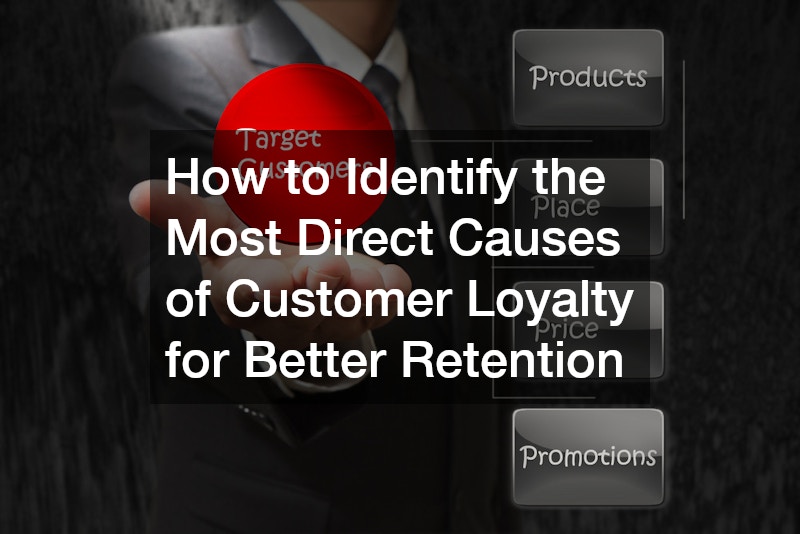Introduction
Customer loyalty is a vital component of any successful business strategy. It not only ensures a steady revenue stream but also lowers marketing costs, as loyal customers often act as brand advocates. At its core, customer loyalty refers to the consistent preference a customer shows for a brand over its competitors. This loyalty translates to higher retention rates, which in turn leads to increased profitability and market stability. In this article, we aim to explore “what is the most direct cause of customer loyalty” and provide actionable strategies for businesses to enhance their customer retention efforts.
While the term ‘customer loyalty’ is frequently used, it is important to distinguish it from brand loyalty. Customer loyalty is based on transactional relationships and experiences, whereas brand loyalty is often deeper and linked to the emotional affinity a customer has towards the brand itself. Understanding these nuances and employing effective loyalty programs and strategies for repeat customers can significantly impact a company’s bottom line. The guide that follows will explore the components of customer loyalty, identify the direct causes, and offer actionable strategies for improvement in customer retention.
The primary objective of this guide is to delve into the direct causes of customer loyalty and how they can be leveraged to foster better retention. By understanding these elements, businesses can design strategic initiatives that resonate with customers, encouraging not just repeat business but genuine appreciation and preference for their brand. This article will provide comprehensive insights covering the quality of product/service, customer experience, emotional connections, trust, engagement, data analysis, loyalty strategies, and measurement techniques, each critical to developing a robust customer loyalty framework.
I. Understanding Customer Loyalty
What is Customer Loyalty?
Customer loyalty refers to the likelihood of repeated purchases or continued support a customer gives a brand. It is significant because it provides the backbone of business sustainability by ensuring that existing customers are retained over time. Unlike brand loyalty, which involves a deep-seated personal affinity towards a brand, customer loyalty can be heavily influenced by transactional benefits such as convenience and satisfaction. Loyalty programs play a crucial role here, offering incentives like discounts and rewards to persuade customers to return. For a deeper dive into the nuances and importance, consider the Definition of Customer Loyalty.
Differentiating between brand loyalty and customer loyalty is critical for businesses to appropriately tailor their marketing strategies. Customer loyalty is more pragmatic and intertwined with the actual experiences customers have with a brand, whereas brand loyalty often involves an emotional or ideological alignment with the brand’s values. A key strategy to foster customer loyalty is implementing loyalty programs that align with customer needs and expectations, enhancing their willingness to return. For example, the use of points-based systems or VIP programs can be particularly effective. It is important to remember that fostering loyalty requires attention to the overall customer experience, ensuring it is both seamless and rewarding.
By understanding the underpinnings of customer loyalty, businesses can develop tactics that not only encourage repeat purchases but foster a sense of trust. As the initial driver of loyalty is often rooted in customer satisfaction, it’s crucial that businesses focus not just on attracting new customers but on retaining and valuing existing ones. Repeat customers are often more valuable than new ones, as they have the potential to generate consistent revenue streams and advocate the brand to others. Implementing loyalty programs can help cement this loyal customer base by offering value that competitors can’t easily replicate.
II. The Most Direct Causes of Customer Loyalty
A. Quality of Product/Service
The quality of a product or service is often cited as the most direct cause of customer loyalty. A high-quality offering not only ensures that the customer’s immediate needs are met but also reassures them of reliability and consistency. Customers are more likely to return if they believe they are receiving value that justifies their investment. Therefore, businesses must rigorously assess their quality standards and make adjustments as necessary. The Importance of Product Quality cannot be underestimated as it forms the cornerstone of customer trust and loyalty.
To maintain high quality, it’s crucial to integrate robust feedback and quality assurance processes into business operations. Regular quality audits and customer surveys can help identify any gaps in service or product offerings. By continuously monitoring and refining these elements, companies can ensure they consistently deliver excellence. This not only helps in retaining current customers but also attracts new ones through positive word-of-mouth. Remember, the perception of reliability can encourage customers to overlook minor issues, reinforcing their loyalty.
In assessing quality, organizations should consider metrics such as product reliability and service excellence, which are critical in shaping customer perceptions. Ensuring that quality is maintained across all touchpoints—from manufacturing to customer service—can help build confidence among consumers. Additionally, empowering employees to focus on quality and customer satisfaction can translate into better experiences for customers. By prioritizing quality, businesses can cement their position as leaders in their respective industries, thus fostering long-term loyalty.
B. Customer Experience (CX)
Customer experience (CX) plays a pivotal role in shaping customer loyalty and is another direct cause that significantly impacts retention rates. From the initial engagement with a brand to post-purchase support, every touchpoint comprising the customer journey holds the potential to either enhance or undermine the customer’s perception. As such, investing in a comprehensive CX strategy is imperative for companies aiming to bolster their customer loyalty initiatives. Businesses that prioritize customer satisfaction and user experience typically see a marked improvement in repeat purchases and brand advocacy. For more insights on this, delve into Customer Experience Strategy.
Creating a memorable customer experience involves understanding the needs and expectations of your target demographics. It starts with mapping out the entire customer journey and identifying opportunities for personalization and engagement. An effective CX strategy should include training employees to provide exceptional service, utilizing technology to streamline processes, and fostering an environment that values customer feedback. By implementing these steps, companies can significantly improve their loyalty metrics while cultivating a customer-centric culture.
Continuous evaluation and improvement of customer experience is essential in maintaining competitive advantage and fostering loyalty. Employing techniques such as journey mapping and feedback loops helps in identifying pain points and areas for enhancement. The use of advanced analytics can uncover valuable insights into customer preferences and behavior, enabling businesses to tailor their offerings more effectively. In this rapidly evolving digital landscape, ensuring a superior customer experience is not just desirable but a necessity for sustaining customer loyalty.
C. Emotional Connection
While quality and experience are foundational, building an emotional connection with customers can be the differentiator between mere satisfaction and true loyalty. Emotional loyalty is developed when customers’ personal values align with the values of a brand, leading to a deeper, more meaningful relationship. Brands that successfully evoke positive emotions and resonate on a personal level with their clientele tend to see higher retention and engagement rates. Effective emotional branding involves storytelling, creating shared experiences, and nurturing a strong brand identity that customers feel proud to associate with. Learn more about the nuances of this approach in Creating Emotional Connections.
Techniques for fostering emotional loyalty include leveraging narrative marketing, engaging in authentic interactions, and highlighting a brand’s purpose beyond the products or services it offers. Connecting with customers through shared values, whether it be sustainability, innovation, or community involvement, can foster strong emotional ties. These connections make customers more likely to support a brand in the long term, even when alternatives are available, due to a deep-rooted emotional investment.
Moreover, emotional connections often lead to greater customer advocacy, as loyal customers are inclined to recommend beloved brands to friends and family. Social proof, testimonials, and influencer partnerships can further amplify emotional ties by fostering a community around the brand. By incorporating these strategies, businesses not only enhance customer loyalty but also cultivate a passionate customer base that actively participates in brand growth. Ultimately, loyalty driven by emotion significantly boosts customer retention and drives long-term success.
D. Trust and Reliability
Trust is a crucial currency in the business-customer relationship, and its significance as a direct cause of customer loyalty cannot be overstated. When customers trust a brand, they are more likely to forgive occasional shortcomings, providing an opportunity for businesses to solidify their standing through consistency and reliability. Building and maintaining trust involves transparency in business practices, upholding promises, and demonstrating accountability. Trust is intertwined with brand reputation, which can be bolstered through positive customer experiences and word-of-mouth endorsements. Businesses striving for loyalty should concentrate on cultivating strong, trust-based relationships with their clientele. Delve into techniques for Building Trust with Customers.
Developing trust begins with clear, honest communication, particularly in advertising and customer interactions. Setting realistic expectations and ensuring that commitments—such as delivery times or service levels—are met helps solidify reliability in the eyes of customers. Trust can also be enhanced by addressing customer concerns promptly and fairly, demonstrating that the company values their business and is committed to continuous improvement. Building a culture of integrity ensures that trust permeates through every facet of an organization, contributing to stronger customer relationships.
Moreover, businesses can measure and reinforce trust by collecting and analyzing feedback from their customer base. Tools such as surveys, net promoter scores, and regular engagement through social platforms can offer insights into areas where trust may be waning, allowing for proactive adjustments. Companies that consistently prioritize trust-building strategies foster environments where customer loyalty can thrive, thereby sustaining their competitive edge in a crowded marketplace.
E. Customer Engagement
Engagement is more than just a buzzword; it’s a proactive approach to creating a dialogue between a brand and its customers that can serve as a strong catalyst for loyalty. Active engagement encompasses more than just communication—it involves creating meaningful interactions that resonate with customers, inviting them to become part of a brand’s journey. Engaged customers are more likely to provide feedback, partake in brand-related events, and advocate on behalf of the brand, thus solidifying their loyalty. To increase engagement, businesses should focus on personalizing interactions and building a sense of community. For actionable strategies, consider reviewing Effective Customer Engagement.
To boost engagement, businesses can employ various tactics such as social media interactions, personalized marketing campaigns, and loyalty rewards that recognize and celebrate customer involvement. Integrating customer feedback into product developments or service improvements can make customers feel valued and integral to the brand’s success. There’s also a growing trend of gamification in customer engagement strategies, where brands offer challenges, credits, or rewards for participation in surveys, contests, or product trials.
Building a robust customer engagement strategy necessitates a detailed understanding of customer preferences and behaviors, achieved through comprehensive data collection and analysis. Segmentation can help tailor content and communications that resonate with different customer groups, ensuring maximum reach and impact. By fostering an engaged customer base that feels connected and appreciated, businesses can significantly boost loyalty and establish enduring relationships. Active, engaged customers often become brand champions, further maximizing the reach and appeal of the company through positive advocacy.
III. Analyzing Customer Loyalty
A. Data Collection Methods

Successful analysis of customer loyalty begins with robust data collection methods. Gathering accurate, comprehensive data helps businesses understand the nuances of customer loyalty and enables the fine-tuning of strategies to improve retention. By deploying tools such as customer surveys, feedback mechanisms, and analytics software, companies can gain impactful insights into customer preferences and behaviors. This enables businesses to tailor experiences, offerings, and overall approaches to meet the specific needs of their customers. Companies should aim to regularly assess the effectiveness of their data collection methods to stay ahead in dynamic markets. For more on techniques, visit How to Collect Customer Feedback.
Data collection should cover various stages of the customer journey to provide a holistic view of customer interactions and satisfaction levels. This includes monitoring customer touchpoints, from initial contact to post-purchase follow-up, aiming for a consistent and seamless experience. Businesses can also leverage technology to automate data collection processes, ensuring efficiency and accuracy. Companies that excel in collecting and analyzing data effectively can anticipate customer needs, thereby refining products, services, and communications to enhance loyalty and engagement.
Through effective use of data, businesses can predict customer churn and implement retention strategies proactively. Data-driven decisions offer businesses the ability to make informed choices that support loyalty programs, personalized communications, and improved customer service. By integrating feedback into actionable insights, companies can develop an agile approach to customer loyalty, swiftly adapting to evolving customer expectations and market challenges. The result is an environment where customer loyalty becomes a fundamental aspect of business transformation and growth.
B. Customer Segmentation
Customer segmentation involves dividing a business’s customer base into distinct groups with shared characteristics. By understanding these segments, companies can tailor their offerings to meet the specific needs and expectations of each group, effectively enhancing customer loyalty. Segmentation criteria can include demographics, buying behavior, geographical location, and psychographic traits. Through effective segmentation, businesses can provide personalized experiences that resonate with each customer group, driving loyalty and satisfaction. To understand segmentation and its importance, refer to Importance of Customer Segmentation.
Engaging with different customer segments through targeted marketing efforts allows brands to communicate relevant messages to the right audiences. For instance, younger demographic segments may respond well to digital advertising, while older segments may appreciate more personalized touchpoints like direct mail. Tailoring communication means businesses can deliver the right message through the optimal channel, thereby increasing the likelihood of positive interactions and fostering deeper loyalty. Consequently, customer segmentation is a crucial step in ensuring consistency, resonance, and efficiency within customer loyalty strategies.
Moreover, segmentation supports effective resource allocation by highlighting which customer groups are most likely to contribute to revenue growth and long-term success. By focusing efforts on high-potential segments, businesses can maximize their return on investment in retention programs. Analyzing customer segments also uncover opportunities for cross-selling and upselling, fortifying the loyalty of existing customers by offering them products or services they may be poised to purchase. These precise, targeted actions ensure customers feel understood and valued, resulting in enhanced satisfaction and loyalty.
IV. Implementing Loyalty Strategies
A. Creating a Loyalty Program
Loyalty programs are a significant driver in enhancing customer retention and encouraging repeat transactions. An effective loyalty program incentivizes customers to continue purchasing by rewarding them based on their engagement with the brand. A program must resonate with its audience to achieve optimal results, offering value that aligns with customers’ desires and expectations. Traditionally, loyalty programs involve point collection, reward tiers, or exclusive benefits for frequent buyers. Businesses can design impactful loyalty programs that elicit strong participation and appreciation by leveraging insights into customer preferences and behaviors. Explore more about effective program designs at How to Design a Loyalty Program.
Designing a program that captivates customers involves listening to their needs and tailoring incentives to match their purchasing habits. Offering personalized rewards or recognizing milestone achievements within the program can make customers feel valued and appreciated. Additionally, keeping the redemption process for rewards simple and transparent can significantly enhance program participation. By introducing exclusive offers or VIP access to events, brands can garner greater customer engagement, deepening their commitment to the brand.
Successful programs prioritize ease of use, seamless integration with existing technology, and dynamic adaptability, allowing for improvements based on feedback and changing needs. Implementing digital platforms and mobile apps for loyalty programs can enhance accessibility, making it easier for customers to engage. Consistent communication around program benefits and updates ensures participants remain informed and motivated. A well-executed loyalty program not only boosts re-purchase rates but also promotes a sense of belonging within the brand community.
B. Personalization Techniques
Personalization is a potent approach for nurturing customer loyalty, involving strategies that tailor experiences to individual customer preferences and behaviors. This customization can range from personalized product recommendations to exclusive offers and curated communications. Customers who feel understood and valued are more likely to exhibit brand loyalty, as their unique needs are acknowledged. Personalization creates a significant competitive advantage, allowing brands to differentiate their offerings in a crowded market. Delve into the strategies that can be employed for effective personalization at Personalization Strategies.
Implementing personalized marketing strategies begins with data collection and analysis, as well as understanding key customer demographics, past interactions, and buying histories. Such insights enable businesses to craft relevant messages that address specific interests and needs, delivered through the right channels at the optimal times. An example of personalization in practice is using an advanced CRM system to automate birthday offers, product suggestions based on browsing history, and real-time cart reminders.
Moreover, personalization fosters stronger emotional connections, as customers appreciate brands that respect their individuality and preferences. Integrating advanced technologies like artificial intelligence and machine learning can enhance personalization efforts, enabling more accurate predictions and tailored experiences. However, companies must balance personalization with privacy ethics, ensuring customers’ data is used responsibly. By excelling in personalization, businesses can create compelling customer journeys that boost satisfaction and foster enduring loyalty.
C. Continuous Improvement
Continuous improvement is crucial in adapting to ever-changing customer expectations and carving a path toward sustainable loyalty. In today’s rapidly evolving market, businesses must remain agile, responsive, and committed to enhancing the customer experience based on real-time insights and feedback. Establishing a feedback loop through surveys, testimonials, and direct communication channels is vital for capturing customer perceptions and areas for growth. Businesses should listen to their customers and actively implement changes that demonstrate commitment to fulfilling their needs. Learn more about obtaining ongoing customer insights on Customer Feedback and Improvement.
Customer feedback is invaluable in informing decision-making processes and shaping business strategies. Encouraging customers to share their insights post-purchase helps identify potential areas for refinement. Continuous monitoring of customer satisfaction and responsiveness to queries directly correlates with increased loyalty, as it builds trust and confidence.

